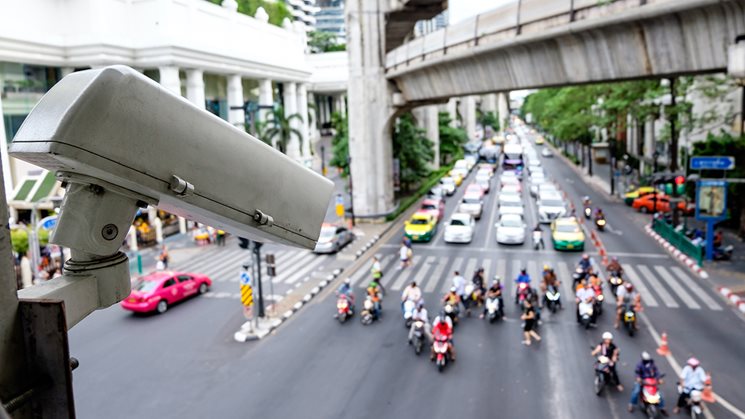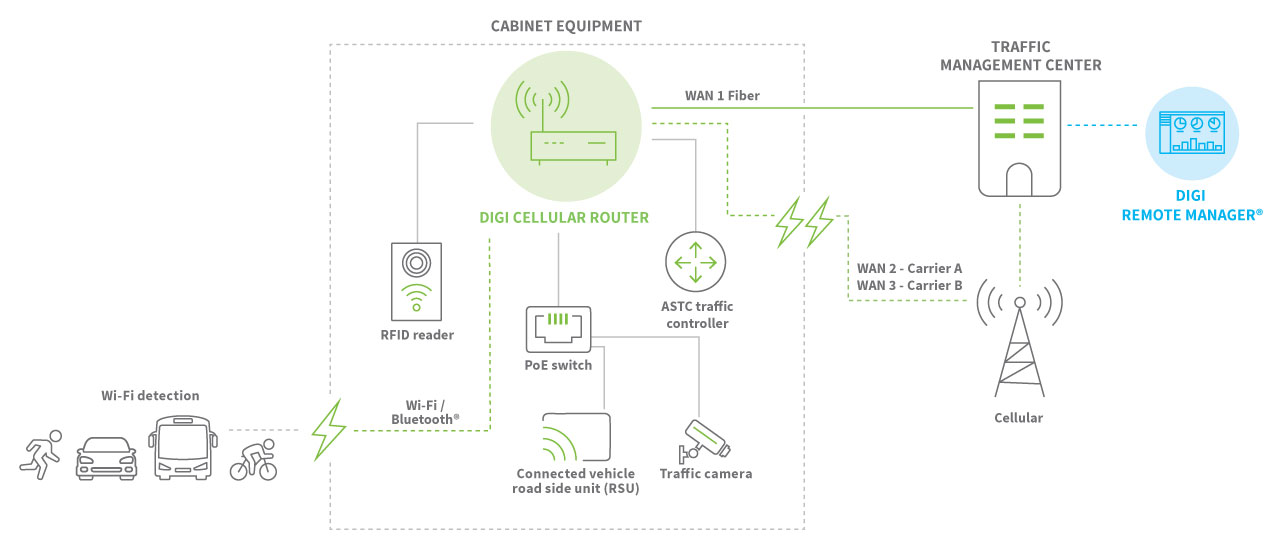Across the U.S., traffic managers are seeking ways to adapt and upgrade their traffic management systems to improve the flow of traffic, ensure first responders can get to their destinations quickly and improve public safety. Additionally, aging infrastructure has become increasingly expensive to maintain, and system reliability has suffered.
Meanwhile, the federal government has targeted billions in funding for infrastructure upgrades. The solutions to support these critical enhancements — including
ready-to-deploy solutions championed by Digi and AT&T — have come light years ahead in their sophistication, security and reliability. All of this makes the timing right for identifying, procuring and deploying technology upgrades. Where to begin?
In this blog post, we introduce a tested, proven, turnkey solution from AT&T and Digi that is available now via the NASPO ValuePoint procurement network, or from your AT&T or Digi sales representative.
The Business Case for Smart City Traffic Management

The challenges traffic managers face today include aging infrastructure, cybersecurity threats, poor performance, and high maintenance costs, in addition to increasing traffic congestion challenges. What’s more, the future has arrived, with the advent of connected vehicle technology, which is designed to make intersections safer and reduce fatalities.
So — you likely won’t have trouble making the case that an upgrade to your traffic management infrastructure is a great idea. But as we know, the questions and concerns around cost, resources, business disruption and return-on-investment can bog down the approval process.
Fortunately, Digi and AT&T offer multiple resources to support your business case.
- See the New York City case study demonstrating how NYC DOT worked with a multi-agency team including AT&T and Digi to roll out intelligent transportation system (ITS) upgrades to 14,000 intersections in record time, with unprecedented ROI, including 99% uptime
- Read the related blog post sharing how the NYC DOT project earned a prestigious ITS award for its rapid, innovative infrastructure upgrade across all five boroughs
- Work with AT&T IoT Professional Services to gather the information needed for your city’s specific requirements so you can best communicate the benefits and ROI of your smart city traffic management project in support of your business case
What Are the Key Benefits?
To begin assessing the migration of your traffic management infrastructure to a high-performance Intelligent Transportation System, here are some of the key benefits your department of transportation can expect with your system upgrade. We will look at two categories of benefits.
System Management Benefits

The advantages of any system upgrade must include everything from cost-reductions to ease-of-use in order to be viable alternatives to what is presently installed. Digi and AT&T smart city traffic management solutions offer these benefits and more to reduce the burden on over-taxed technical teams:
- Rapid configuration: Digi’s proven, zero-touch configuration methodology, using Digi Remote Manager®, enables IT teams to preconfigure routers en masse so that field technicians can install in record time, dramatically reducing cost and deployment time.
- System-wide visibility and management: Digi Remote Manager (Digi RM) also supports complete, system-wide visibility, alerts, mass firmware updates and rapid, drop-in hardware replacements, in the event of an equipment failure.
- Reliability: As we’ve discussed, your traffic management system will benefit from dramatically higher reliability, with the NYC DOT 99% uptime benchmark as a notable example. This is due to the built-in redundancy and high-performance, multi-carrier failover features of the Digi LTE-Advanced transportation solutions, and the inherent reliability of cellular connectivity, vs. fiber and copper lines.
Smart City Benefits

The smart city movement has brought about a paradigm shift, where pre-programmed operation of traffic lights is no longer sufficient. New technology and applications that have been proven to deliver enormous safety benefits in urban centers require reliable broadband communications, via cellular networks. These include:
- Adaptive control: Detected vehicle congestion triggers changes to traffic signal timing to optimize traffic throughput in near real-time.
- Congestion detection: Traditional single-vehicle detector loops are replaced with radar and camera systems enabling detection of entire vehicle queues and therefore congestion.
- Connected vehicle: A key objective is to prevent accidents through near real-time communication between vehicles, pedestrians (smart phones) and the traffic control system.
- Bus Rapid Transit: Traffic signal timing is adjusted to maintain schedules of BRT transit buses.
- Emergency routing: A path through the city is coordinated for first responder vehicles, using congestion data and vehicle location to adapt route guidance and traffic signal timing.
- Public safety: With automation and controls at intersections, your urban center will experience safer transportation for vulnerable road users such as pedestrians and cyclists. Additionally, your traffic management system will be part of the FirstNet® network, ensuring emergency teams have priority and pre-emptive communications during public emergences.
Today, departments of transportation deploying infrastructure upgrades to take advantage of these new technologies are experiencing better traffic flow, improved emergency response and a reduction in traffic accidents and pedestrian fatalities. The heart of these deployments is a smart city traffic management system.
Turnkey Traffic Management Solutions for Rapid Deployment
With deep experience in deploying cutting edge smart city traffic management solutions, AT&T and Digi combined all the key components into a turnkey solution for rapid rollout in urban centers across the U.S. Here is an overview of the solution.
The Traffic Management Center (TMC) is the central facility where vehicle and pedestrian movement is monitored and controlled. AT&T network connectivity and wireless routers provide secure and reliable communications between intersection equipment and the TMC. The diagram below presents the various entities and their connections. The principal system functions are listed below in the diagram.

- Backhaul communications. Multiple concurrent cellular and fiber links ensure continuous communications with the TMC. IPsec VPNs ensure secure passage through any network.
- Local network. The router’s built-in four-port Ethernet switch supports connections to IP-enabled equipment within the cabinet. A Power-over-Ethernet (POE) switch expands the port count and supplies power to multiple IP cameras.
- Legacy equipment. A serial port is provided for connection to legacy devices such as an RFID reader. Typically, a server application accesses the device using virtual comm port redirection.
- Local management. The router supports simultaneous client and access point Wi-Fi operation. Nearby authorized personnel can download heavy data such as stored video files, or manage cabinet equipment using a laptop or handheld device.
- Wi-Fi detection. Anonymized data from passing Wi-Fi or Bluetooth devices are sent to a central server for travel time analysis and displays.
Installation of the field equipment is straightforward. The router and power supply are situated on a shelf within the cabinet, and connect to existing equipment by Ethernet, serial or USB cable. The antenna is fixed to the cabinet roof, with the RF cables entering the cabinet via a threaded thru-hole stud mount, sealed to prevent water ingress into the cabinet.
Installers in the field can perform installations at each intersection in 45 minutes or less. Site activation is aided by automated configuration updates using Digi RM. Any site-unique parameters are preloaded into Digi RM, which automatically download when the router first connects. Dashboards show connection status and key performance data, designed to spot trouble if present. A quick speed test can confirm full operation in preparation for site commissioning.
NASPO ValuePoint: Bypass Lengthy Procurement Processes
The turnkey solution from AT&T and Digi is available to government entities across the U.S. from the NASPO ValuePoint procurement system. The integrated solution includes:
- AT&T IoT Professional Services: Provides a full spectrum of smart traffic infrastructure enablers, including full turnkey deployment and implementation services and building a business case and ROI for smart traffic projects.
- Digi TX54 Cellular Router: Rugged and secure cellular router for mission critical industrial and transportation applications, including models for public safety networks.
- Digi Remote Manager®: Digi’s comprehensive device configuration and monitoring application allows municipalities to provision and monitor network of cellular routers and extenders as they are deployed, with “zero touch provisioning” in the field. Digi Remote Manager is also PCI, HIPPA and NIST approved.
- Digi TrustFence®: a comprehensive security framework integrated into Digi's cellular routers, cellular extenders, and console management products.
- Digi Professional Services: Together with AT&T Professional Services, Digi can conduct site surveys and application development, as well as team training and on-site deployment services to help ensure successful deployment.
This means that once you have your business case in hand, the rest is straightforward. The typical complications of assembling hardware, software, services and components are not a factor. It’s all combined, with line item costs — dramatically simplifying the entire procurement process. And you’ll have professional services team to support your rollout.
Click here to get more information. Or
联系我们 to start the conversation, and a Digi representative can answer questions and guide you through selection and procurement.